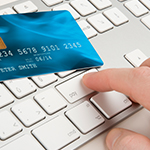
Online banking is great, isn’t it? You can switch on your PC, smart phone or tablet, then pay a bill, check your bank balance or even move money from one place to another – all from the comfort of home.
Gone are the days when we had to wait for the bank to open. And we love it. So much that in 2013, more than 50 percent of people in the U.S. chose the convenience of online banking to access their accounts. Unfortunately, we are not the only ones watching this increase in online banking.
Cybercriminals will always be found where there is money to be had. Online banking provides another opportunity for them to try and get ahold of your account details or trick you into handing over security information like usernames, passwords and memorable details. Safe baking online starts with an awareness of the tricks cybercriminals use to get their hands on your money.
Trade secrets of a cybercriminal
There are two routes the hacker will use to access online bank accounts: phishing and password theft.
Phishing - You receive a hoax email that looks like it’s from your bank. The scam tells you to click a link in the email, taking you to a fake website that looks like your bank’s site. You type in your security details, thinking they are secure, and that is it – you have handed your details to a fraudster.
Password theft - Cybercriminals can trick you into installing a program on your computer that records what you type. So, when you next log on to your online account the program will secretly record your password details and send them to the fraudster. Job done.
The next thing you know your bank card is declined and you discover your account has been emptied. But don’t worry.
Just as you can lock your front door to reduce the chances of a break-in, you can take steps to minimize the risk of online banking fraud.
Fight back
To ensure safe banking on the Internet just think about YOUR MONEY:
- You should regularly check your account and credit card statements for suspicious transactions. If you see something strange, report it to your bank as soon as possible.
- Only enter account details on web pages with a padlock symbol in your browser and where the web address has changed from http to https - this means the connection is secure.
- Use common sense and be cautious. Don’t click pop-ups or links in emails that say they are from your bank. Instead, type your bank’s full website address into your browser. Double-check if a message is genuine, and call your bank.
- Received a call or email from your bank you weren't expecting? Treat it with suspicion and never disclose personal details in emails or unless you have called the bank yourself.
- Mix letters and numbers when you choose your password to make sure it’s not easy to work out. Never write your password down.
- Only access your bank account from a secure wireless network. If you do use a public computer, never leave it unattended when logged in and log out properly when you've finished your banking session.
- Never post personal information that could reveal your banking details on social network sites.
- Email attachments from websites you don’t trust are a big warning sign. Don’t open them.
- Your computer needs good security software to protect it against malicious programs and cyberattacks. Protect your PC now with Kaspersky Internet Security .
The legal bit
If you think you have become a victim of online bank fraud, contact your bank report your suspicions immediately.
Fraud victims do have legal protection, so you will not be liable for any losses unless you have acted fraudulently or without reasonable care. It’s also your bank’s responsibility to pass on details of the fraud to the police so you don’t have to.
Get in touch with your bank if:
- You spot any unauthorized transactions on your online bank statement.
- You think you have disclosed information to a fake website.
- You believe that any of your passwords have been captured by malware.


